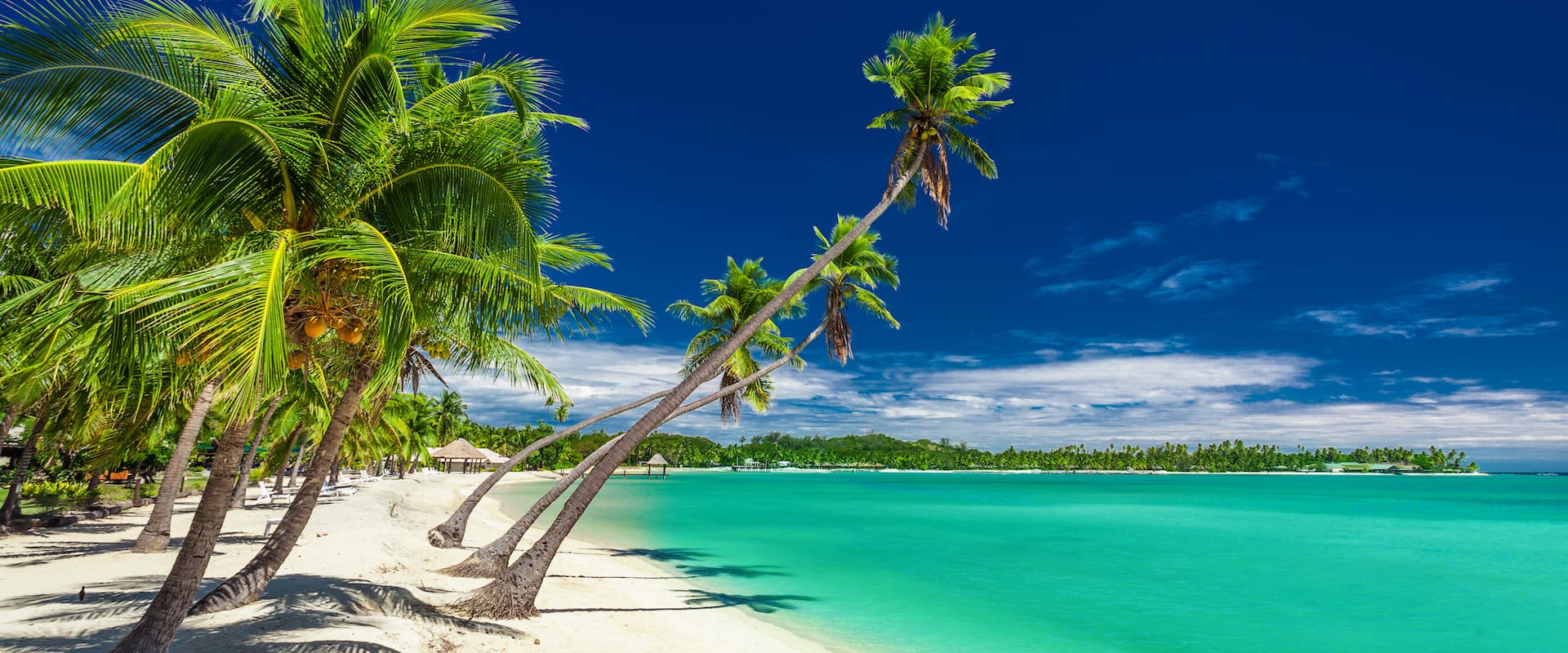Liveaboard Diving in Fiji
With over 4000 square miles of stunning coral reef, Fiji offers divers adrenaline pumping shark encounters and tranquil manta rays visits.
Fiji, the heart of the South Pacific, a beautiful country with a friendly and fun local native culture that consists of 333 islands. That makes Fiji a great liveaboard diving destination. Jacques Cousteau mentioned it to be the Soft Coral Capital of the World. Enjoy the underwater wonders and stunning sunsets above. Liveaboard dive tours in Fiji will take you to less-visited, beautiful remote and colourful reefs with pristine corals.
You will be needing an extra pair of eyes to keep track of both the Fijian macro wonders as well the big fish, Fiji's reefs have it all. From the largest manta ray to the smallest seahorse, nudibranchs, ghost pipefish, crabs, shrimps, ribbon eels and pygmy seahorses. White- and blacktip reef sharks circle around grey reef sharks, manta rays and hammerhead sharks. Also to be seen commonly are turtles, schools of jackfish, fusiliers, barracuda and many more.
In Fiji you'll also experience differing diving conditions. While some places offer calm waters and little current for beginner divers, at most sites slight to strong currents can be experienced. These currents, however, affect the visibility positively. Incoming currents bring clear water into the lagoons while outgoing currents take out the cloudy water from out of the lagoon. Fiji liveaboard safaris bring you to to the best places at the best time of the year. They depart from the main island Viti Levu. The stretch of sea between the main Island Viti Levu and Vanua Levu is very nutrient rich water since there is so much water moving through and there are huge numbers of smaller fish to be seen. Dive sites such as Bligh Waters and Namena here can be enjoyed. At islands like Gau, Makongi and Wakaya you'll be drift diving in between coral gardens and pinnacles with manta rays and hammerhead sharks and also ribbon eels, leaf fish and others. Schools of sharks you can experience in the Nigali Passage.
Fiji liveaboard cruises depart from Suva. They usually leave early in the morning, so you can still enjoy a full day of diving.
Liveaboards in Fiji offer comfortable cabins sleeping up to 16 guests in twin or double bedded rooms. All meals onboard are usually included in the trip cost and provide much needed nourishment for hungry divers. Cabins are air-conditioned with en-suite facilities.
Dive Sites And Areas Of Fiji
Namena Marine Reserve is one of the most diverse ecosystems in the Fiji Islands with very deep drop-offs where you find the entrance to the North Save-a-Tack Passage. Magic Mound is home to white tips and keep an eye out for barracuda and tuna at North Save a Tack. On its opposite site south you'll find bommies (seamounts) called Chimneys, Magic Mountain, Pirates Den and many more. This is a perfect Liveaboard destination because land-based dive operators cannot guarantee a visit to this pristine dive site due to weather conditions and other factors.
Makongi Island - At Coral Gardens there are more bommies with turtles, white tips, moray eels and sometimes nurse sharks. The passage to the inner reef is Makongi Channel, usually this makes a great drift dive. At the entrance of Makongi Channel you find White Rock with its white top. Here you find white tips, eagle rays, manta rays, eels, hard and soft corals.
At Rustic Arch there are beautiful hard and soft corals, sea anemones, moray eels, white tips and a resident Napoleon wrasse.
Gau island - Koro Gardens consists of one large bommie covered by hard corals which attracts many reef fish with maximum depths varying from 45 feet to 95 feet.
Shark Fin Point is a spectacular dive site where you can see large schools of about 500 barracudas, eagle rays, many white tips, lots of grey reef sharks, lobsters, eels, and by times a whale shark. In case of strong currents it makes a great drift dive.
Wakaya island - Gem Stone is a wall dive where manta rays can be seen together with hammerhead sharks and white tips. Light fish make your night dive here one to remember!
Wakaya Pass is a wall dive with 140 feet down to the bottom. Along the wall you may see blue ribbon eels, white tips, nurse sharks, and hammerhead sharks along with manta rays, marble rays, turtles, eagle rays and barracudas.
When To Go
In Fiji, you can dive all year round. Visibility is best from July until December when the water is coolest at 22-25 degrees . Summer in Fiji is from November to April, this is the rainy season with water temperatures of 28-30 degrees. The waters then are rich with plankton which attracts big fish like whales and manta rays.
Tips For Travellers
- Be sure to bring your dive certification card and logbook as most liveaboards will require to see proof of certification level and experience.
- The local time is 12 hours ahead of UTC (GMT)
- The local currency is the Fijian Dollar (FJD). Visitors are advised to make any currency exchange at the airport, prior to leaving the terminal building.
- Languages spoken in Fiji are Fijian and Hindi but everyone is united by English.
- Electricity current in Fiji is 240 volts AC 50 Hz with three-pin power points - the same as in Australia and New Zealand.
- Visitors staying less than 4 months in Fiji do not require a visa.
How To Get There And Ports Of Departure
Ports of departure of our Liveaboard Vessels is Suva. Nadi International Airport is the main airport of Fiji. Daily, 4 or more domestic flights leave from Nadi to Suva. Nausori Airport is Fiji's second International Airport and is situated on the eastern side of Viti Levu, just 30 minutes from Suva.
Considerations
In case of an emergency, an air evacuation may be required so a diving specific insurance is recommended.
There are several marine park fees. Also on most liveaboard vessels merchandise, services and alcoholic beverages need to be paid on board. These can be paid in different currencies and by credit card. Keep in mind, however, using your credit card, an extra fee of mostly 3- 4% on top of your bill. Also, some fees will be subject to Fiji Government Taxes: VAT of 9%, Services Turnover Tax of 10% and Environmental Levy of 6%.
Passports should be valid for at least 6 months after return to the country of origin. Most visitors who intend to stay for less than 4 months do not require a visa.
Concerning vaccinations visitors should consult with their doctor 8 weeks ahead.
A Fiji liveaboard is diversity itself. Current-swept reefs bring schools of barracuda, sharks and manta rays, set against a backdrop of tranquil coral reefs full of critters and bright tropical fish. Jacques Cousteau once described Fiji as “the soft coral capital of the world”.
Fiji Diving Reviews
- 8.7 Fabulous
- 9.6 Exceptional
- Shawn W
United States
Amazing - better than we expected!
Diving Fiji in March on the Nai'a
- 8.8 Fabulous
- George L
United States
It was good but we saw mostly coral both hard and soft but not too many fish. Only baby fish.
Diving Fiji in May on the Reef Endeavour
- 10.0 Exceptional
- Claudia F
United States
Spectacular diving!!
Diving Fiji in December on the Reef Endeavour
- 10.0 Exceptional
- Charlotte B
United States
There are a lot of locations with coral and small creatures. At times was monotonous, but was able to see some palegic marine life
Diving Fiji in October on the Nai'a
- 10.0 Exceptional
- BETH W
United States
Most excellent
Diving Fiji in October on the Nai'a
- 8.0 Very good
- Thomas B
United States
Snorkeling was very good- with a few exceptions. One scuba dive was average; the other was excellent. Might have benefitted if sites were checked for visibility. Cost seemed high for single tank dives.
Diving Fiji in August on the Reef Endeavour
- 5.2 Review score
- Lee B
United States
Very disappointing. Lots of dead coral and very few larger fish
Diving Fiji in May on the Reef Endeavour
- 6.0 Review score
- Susan W
United States
Disappointing
Diving Fiji in April on the Reef Endeavour
- 9.2 Superb
- Michael J
United States
Great, good weather too end of March
Diving Fiji in March on the Nai'a
- 10.0 Exceptional
- Matthew M
United States
First time in Fiji, and plan to return. Great biodiversity, reefs healthy.
Diving Fiji in March on the Nai'a











